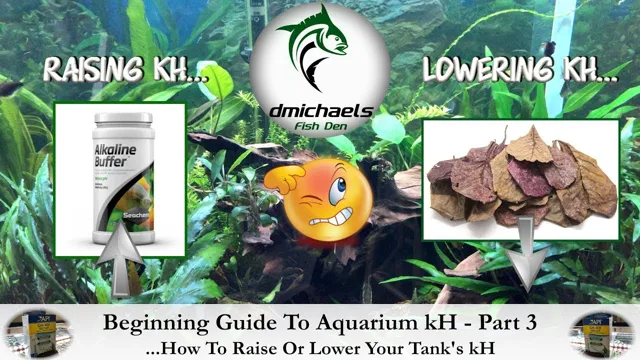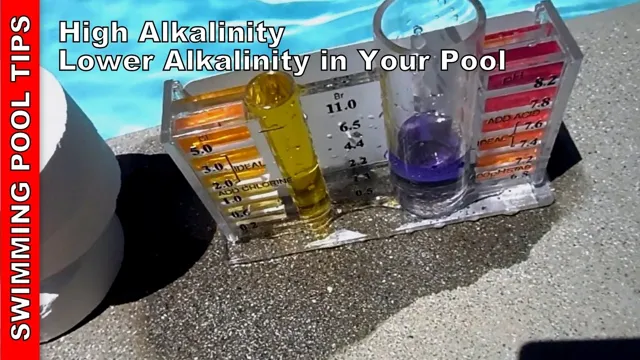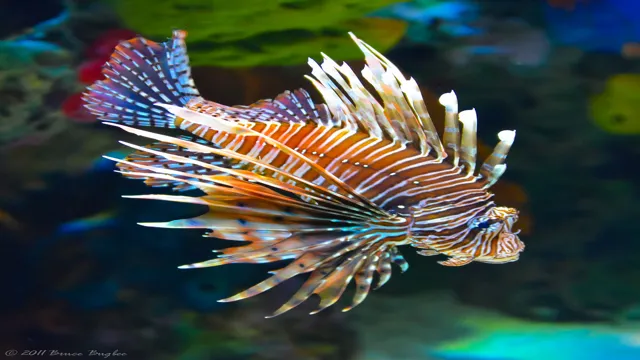How to Lower High Alkalinity in Aquarium: Effective Tips and Tricks

Have you been struggling to maintain the right water conditions for your aquarium? One of the most critical parameters to keep in check is the alkalinity levels of the water. High alkalinity can lead to various issues, including pH instability and fish and plant stress, among others. Fortunately, lowering the alkalinity in your aquarium is not rocket science.
In this blog post, we’ll be sharing some tips on how to lower alkalinity in your aquarium to ensure a safe and healthy aquatic environment for your finned friends. So, grab your notebook and let’s dive in!
Understanding Alkalinity in Aquarium
If you’re experiencing high alkalinity in your aquarium, don’t fret, you’re not alone. Alkalinity refers to the ability of water to neutralize acids, and a high alkalinity means that there is an excess of bicarbonate and carbonate ions in the water. This can lead to issues such as pH instability and coral bleaching.
To lower high alkalinity in your aquarium, there are a few steps you can take. First, you can perform a water change with reverse osmosis or deionized water to dilute the alkalinity levels. Second, you can add an acidic substance such as vinegar or citric acid to the water to lower the pH levels.
Lastly, you can use a specialized alkalinity reducing product that contains calcium chloride or magnesium chloride. By taking these steps, you can ensure that your aquarium is healthy and balanced for your fish and coral to thrive.
What is Alkalinity?
Alkalinity is an essential parameter to maintain in a healthy aquarium. It’s a measure of the water’s ability to resist changes in pH, usually caused by the addition of acid or base. In simpler terms, it’s the water’s buffering capacity, a measure of how well the water can handle fluctuations in acidity.
Alkalinity is normally measured in terms of carbonate hardness (KH) and indicates the level of dissolved carbonates and bicarbonates in the water. Maintaining the right level of alkalinity is vital for keeping fish, invertebrates, and coral healthy in a marine ecosystem. An adequate alkalinity level helps to stabilize the pH level, prevent pH crashes, and minimize stress on the aquarium inhabitants.
Therefore, it’s crucial to regularly check and adjust the alkalinity level of the aquarium water to keep all the marine organisms thriving.

Why is Alkalinity Important in Aquariums?
Alkalinity is an important concept to understand when it comes to aquarium maintenance. In simple terms, alkalinity refers to the ability of water to neutralize acids. It’s measured in terms of carbonate hardness, which is a measure of the bicarbonate and carbonate ions present in the water.
Maintaining proper alkalinity levels is crucial for the health of your aquatic creatures. Low alkalinity levels can lead to pH drops, which can be harmful to fish and invertebrates. On the other hand, high alkalinity can cause a slow and steady rise in pH, leading to excessive algae growth, and other negative effects.
You can measure alkalinity levels with a simple test kit, which is widely available at pet stores. Remember to maintain proper alkalinity levels by adding buffers or performing water changes as needed. By doing so, you can ensure a healthy environment for your aquarium’s inhabitants.
What is Considered High Alkalinity in an Aquarium?
Alkalinity in an aquarium refers to the level of bicarbonate ions present in the water. It is an important aspect to consider for the well-being of aquatic plants and animals as it helps to stabilize pH levels and prevent sudden fluctuations. When the alkalinity levels rise above the recommended range of 7-12 dKH, it is considered high and can lead to various issues.
A high alkalinity level can trigger the formation of harmful algae blooms, cause pH imbalances, and negatively impact the growth and health of fish and invertebrates. To maintain the optimal alkalinity range, it is essential to regularly monitor the water chemistry and make necessary adjustments, such as performing partial water changes and using alkalinity supplements. By understanding the importance of maintaining the correct alkalinity levels in an aquarium, hobbyists can ensure a thriving and healthy aquatic environment for their aquatic pets.
Causes of High Alkalinity in Aquarium
If you’re having trouble with high alkalinity in your aquarium, there are a few culprits to consider. One of the primary causes of high alkalinity is the buildup of waste and debris in the tank, which leads to an increase in carbonates and bicarbonates. Another potential factor is an overabundance of minerals in the water supply, which can increase the overall alkalinity.
To combat high alkalinity, you must first identify the root cause. This may involve performing regular water tests to track changes, maintaining consistent filter cleaning and water changes, and ensuring that you’re using the correct type of water when topping off the tank. Once you’ve identified the problem, you can take steps to lower the alkalinity by using acid buffers, adding natural substances like peat moss or driftwood, and adjusting your water change schedule.
With a little bit of diligence and effort, you can successfully lower the alkalinity in your aquarium to create a healthier and more balanced environment for your fish and plants to thrive!
Tap Water and Water Changes
When it comes to maintaining a healthy aquarium, understanding the water chemistry is crucial. High alkalinity is a common issue that aquarium owners face, and it can have several causes. One of the most common causes of high alkalinity in aquariums is tap water.
Depending on local water sources, tap water can have a high pH and carbonate hardness, both of which contribute to high alkalinity. Water changes are also important to consider when addressing high alkalinity, as using tap water with high alkalinity in water changes will only perpetuate the problem. It’s important to test the aquarium water regularly and adjust with additives or treatments as necessary to maintain a healthy balance.
In addition to tap water and water changes, overfeeding and decaying organic matter can also contribute to high alkalinity. By identifying the cause and taking appropriate measures, aquarium owners can maintain a healthy and thriving aquarium environment for their fish and other aquatic creatures.
Overuse of Buffering Products
Overuse of buffering products can cause high alkalinity levels in an aquarium. Buffering products are used to maintain a specific pH level in aquariums. However, using too much can cause the alkalinity to rise, which can be harmful to fish and other aquatic life. (See Also: How to Avoid Water Stain on Aquarium: Tips and Tricks for Spotless Glass Surfaces)
This is because high alkalinity can affect the ability of fish to breathe and can also harm the plants in the aquarium. It’s important to monitor the alkalinity levels in your aquarium regularly and only use buffering products as needed. Overuse of these products can do more harm than good, so it’s best to use them sparingly and only when necessary.
Decaying Organic Matters
Decaying organic matter is one of the main causes of high alkalinity in aquariums. When fish and other aquatic creatures excrete waste, the bacteria in the water begin to break down the organic matter, releasing ammonia and other toxins into the water. If the water is not properly circulated and filtered, these toxins can build up and cause the pH level to rise, leading to high alkalinity.
Additionally, overfeeding your aquarium inhabitants can also contribute to increased organic matter and higher alkalinity levels. To prevent this, be sure to monitor your fish’s feeding habits and clean the tank regularly, replacing a portion of the water every week. It is also important to invest in a good filtration system to keep the water clean and healthy for your fish.
By properly maintaining your aquarium, you can ensure that your fish remain happy and healthy in their aquatic home.
Presence of Live Rocks and Substrates
Live rocks and substrates can contribute significantly to the high alkalinity in an aquarium. These materials release a wide range of elements and compounds into the water, increasing the carbonate hardness (KH) and the pH level. These components include calcium, magnesium, and carbonates and are essential for the growth and survival of corals, invertebrates, and other marine life.
However, excessive KH levels can create an unstable environment that could harm the tank’s inhabitants, as well as impede the growth of specific coral species. Regular monitoring and maintenance of the water chemistry, including testing and partial water changes, can help regulate the pH and KH levels in the aquarium. Additionally, using a refugium or a protein skimmer can help remove excess nutrients that contribute to the high alkalinity levels and promote a healthy and vibrant aquatic ecosystem.
Testing Alkalinity in Aquarium
One of the most important aspects of maintaining a healthy aquarium is keeping the water’s alkalinity level stable. High alkalinity can cause harm to aquatic plants and animals, prompting aquarium owners to wonder how to lower it. The best way to test alkalinity is by using a test kit specifically designed for aquariums, which measures the amount of carbonate and bicarbonate present in the water.
Once you’ve determined the alkalinity level, there are several steps you can take to decrease it, such as adding an acid buffer or using reverse osmosis to dilute the water. It’s essential to address high alkalinity promptly as it can lead to further water chemistry imbalances. By monitoring and maintaining proper alkalinity levels, aquarium owners can create a healthy environment for their aquatic pets.
Types of Alkalinity Test Kits
Aquarium enthusiasts know the importance of maintaining the right water chemistry for their marine pets. One crucial aspect of aquarium water quality is its alkalinity level. To ensure an appropriate alkalinity level, using a reliable alkalinity test kit is crucial.
One type of kit detects total alkalinity, while another kit measures carbonate alkalinity. There are also test kits that can measure both at the same time. It’s always advisable to choose a test kit with clear and straightforward instructions to get accurate results easily.
Remember, the importance of alkalinity rests on its role in the buffering system in aquarium water. Having the right alkalinity level can help stabilize the pH level and promote healthy marine life. So, investing in a trusted and reliable alkalinity test kit can provide peace of mind and keep your aquarium’s water chemistry in check.
How to Perform Alkalinity Test
Performing an alkalinity test in your aquarium may seem like a daunting task, but with the right tools and knowledge, it can be a simple process. Alkalinity is the measure of the water’s ability to neutralize acids and maintain a stable pH level, making it an essential parameter to monitor for a healthy aquatic environment. To test for alkalinity, you will need a pH test kit or a dedicated alkalinity test kit that measures carbonate hardness (KH).
First, fill a small test tube with water from your aquarium, add the required drops of test solution, and shake the tube vigorously. Then, compare the color of the water to the kit’s color chart to determine the alkalinity level in your aquarium. Ideally, alkalinity levels should be between 120-180 mg/L.
Maintaining the correct alkalinity level in your aquarium will help protect your fish and plants from harmful pH swings and ensure a healthy aquatic environment.
Lowering Alkalinity in Aquarium
If you’re experiencing high alkalinity in your aquarium, don’t worry, there are ways to safely lower it. One way is to do partial water changes with low alkalinity or RO/DI untreated water. Another method is to use chemical additives specifically designed to lower alkalinity levels such as pH adjusters or buffers.
It’s also important to monitor the pH level in your aquarium as well, as a decrease in alkalinity can cause a drop in pH. Keeping an eye on these levels and making gradual changes will ensure the health and happiness of your aquarium inhabitants. High alkalinity could lead to health problems for fish and can also cause color problems.
So, ensure you do what you can to maintain it at optimal levels.
Reduce Flux of Carbonate Minerals
Reducing the alkalinity in your aquarium is an effective way to decrease the flux of carbonate minerals, specifically calcium and magnesium. This is important because high levels of calcium and magnesium can lead to the buildup of unwanted deposits on your aquarium’s surfaces, such as rocks, gravel, and even your fish’s gills. By lowering the alkalinity, you can stabilize the pH levels in your aquarium, making it a safer and more enjoyable environment for your fish and other aquatic life.
There are a few ways you can accomplish this, such as using a commercial buffer product, or regularly changing out a percentage of the water in your tank with distilled or reverse osmosis water. Regardless of your method, maintaining appropriate levels of alkalinity is key to keeping your aquarium in top condition. (See Also: How to Plant Aquarium: Beginner’s Guide to Aquatic Gardening)
Using Reverse Osmosis Water for Water Change
If you are looking for a way to lower the alkalinity in your aquarium, using reverse osmosis water for water change is a great solution. Alkalinity is important for maintaining a stable pH level in your aquarium, but too much of it can lead to problems such as unhealthy fish and algae growth. Reverse osmosis water has low alkalinity, making it ideal for diluting the alkalinity in your aquarium water.
This allows you to maintain a stable pH level while keeping alkalinity at a healthy level for your fish and plants. By using reverse osmosis water for water change, you can create a healthier environment for your aquarium inhabitants. So why wait? Start improving the quality of your aquarium water today by incorporating reverse osmosis water into your water change routine!
Decrease Use of Buffering Products
If you’re having trouble keeping your aquarium’s alkalinity levels balanced, one solution may be to decrease your use of buffering products. While these products can help regulate pH levels, they can also increase alkalinity, which can negatively impact your aquatic environment. Instead, consider using natural methods to lower alkalinity such as adding driftwood, peat moss, or other natural materials that can release tannins into the water.
You can also perform partial water changes with distilled or reverse osmosis (RO) water to help dilute and lower alkalinity levels. By reducing your reliance on buffering products and utilizing natural methods, you can maintain a healthy and balanced environment for your aquatic pets.
Increase Aeration and Water Flow
If you’re struggling to lower the alkalinity in your aquarium, one simple solution is to increase aeration and water flow. By doing so, you’ll introduce more oxygen into the tank, which will help to break down the alkalinity and release carbon dioxide. This process is known as gas exchange, and it can be achieved with the help of a bubbler or air stone, as well as a powerhead or canister filter to increase water circulation.
Not only will this improve water quality and reduce the risk of algae growth, but it will also create a happier, healthier environment for your aquatic pets. So if you’re looking for an easy way to maintain optimal water chemistry and minimize the need for chemical adjustments, try ramping up your aeration and water flow to keep your aquarium in balance.
Adding Acid Buffering Chemicals
Lowering alkalinity in aquariums can be a daunting task for many aquarium owners. One effective strategy is to add acid buffering chemicals to the water. These chemicals work by neutralizing and reducing the alkalinity of the water, making it easier to maintain a healthy balance for the aquatic life.
One popular acid buffering chemical is Seachem Acid Buffer, which contains phosphoric acid and sodium acid sulfate. This product is easy to use and can be added directly to the water. However, it is important to follow the instructions carefully and monitor the pH levels regularly as too much acid buffering can damage the aquatic life in the aquarium.
Overall, using acid buffering chemicals can be an effective and safe way to lower alkalinity in aquariums and create a healthier environment for your aquatic pets.
Maintaining Alkalinity in Aquarium
Maintaining alkalinity in an aquarium can be a bit challenging, especially when the pH levels are not balanced. High alkalinity can be detrimental to your aquatic life, as it can lead to stress and even death. If you are wondering how to lower high alkalinity in your aquarium, there are a few steps you can take to ensure your aquatic friends live in a healthy environment.
First, you should test your water to determine the exact levels of alkalinity in your aquarium. Once you have determined the level of alkalinity, you may need to do a partial water change to reduce the overall levels of alkalinity. Adding water with a lower pH can help to balance the alkalinity levels, ensuring a safe and healthy environment for your aquatic life.
Additionally, you can consider using a buffering agent or alkalinity supplement to keep your pH levels balanced and within the recommended range. With these steps, you can maintain the right balance of alkalinity in your aquarium and ensure your aquatic life thrives happily.
Regular Water Testing and Monitoring
Maintaining Alkalinity in Aquarium One of the most crucial factors for maintaining a healthy aquarium is monitoring the pH level and maintaining the right alkalinity. If the alkalinity level is not consistent, it can cause fluctuations in pH levels and lead to stress and disease in fish and other aquatic organisms. Regular water testing using a pH test kit helps to keep tabs on the alkalinity level and ensure that it remains within the optimal range.
Maintaining alkalinity is also critical for the health of aquatic plants and coral as it helps to maintain their color and encourage growth. In addition, ensuring that the alkalinity level is consistent will help prevent any imbalance in the aquarium ecosystem, leading to a healthier environment for fish and other organisms. To maintain the right alkalinity level in your aquarium, it’s important to use additives that contain buffers, such as carbonate and bicarbonate.
These chemicals help to balance the pH and maintain the alkalinity level within the optimal range. It’s important to follow the instructions on the product label and use the correct dosage, so the chemicals don’t interfere with the aquarium’s delicate ecosystem. In conclusion, maintaining the right alkalinity level is crucial for the overall health of your aquarium’s inhabitants.
Regular water testing and using additives that contain buffers can help ensure that the pH level of your aquarium remains within the optimal range. By doing so, you can create a healthy and thriving aquatic environment for your fish, plants, and other organisms to enjoy.
Periodic Water Change
Maintaining alkalinity in an aquarium is one of the most important aspects of keeping a healthy and thriving aquatic environment. One way to do this is by performing periodic water changes. Over time, the buildup of waste and decaying matter in the tank can lead to a decrease in alkalinity levels, which can be harmful to the fish and other aquatic life.
By regularly changing out a portion of the water, you can help dilute any harmful substances and replenish essential minerals and nutrients in the tank. This not only helps maintain alkalinity levels but also promotes overall water quality and clarity. When performing a water change, be sure to use a dechlorinator to remove any harmful chemicals that may be present in tap water. (See Also: How to Make Aquarium Water Bridge: Step-by-Step Guide for Stunning Fish Tanks)
Additionally, make sure the new water you are adding is the same temperature as the water in the tank to avoid any shock to the fish. By incorporating regular water changes into your aquarium maintenance routine, you can help ensure a healthy and thriving aquatic ecosystem for years to come.
Moderate Use of Buffering Products
Maintaining alkalinity in an aquarium is key to ensuring the health of your aquatic pets. One effective way to achieve this is through the moderate use of buffering products. These products are designed to regulate the pH of the water and stabilize alkalinity levels.
However, it’s important to note that overuse of buffering products can lead to fluctuations in pH levels, which can be harmful to your aquatic pets. Aim to use these products in moderation, following the instructions provided by the manufacturer. It’s also important to regularly test pH levels and make adjustments as needed to maintain the ideal alkalinity range for your specific aquarium.
By doing so, you’ll be able to create a healthy and stable environment for your aquatic pets to thrive in.
Proper Maintenance of Live Rocks and Substrates
Maintaining alkalinity in aquariums is crucial for the health and well-being of your marine fauna and flora. This is because the alkalinity in the water helps maintain a stable pH level, preventing harmful fluctuations that can negatively impact your aquatic ecosystem. To maintain the alkalinity of your aquarium, you need to perform regular water changes, monitor the alkalinity levels using a test kit, and supplement the water with minerals and additives that help maintain the pH balance.
If you notice any changes in the alkalinity levels, take immediate action to remedy the situation. Failure to do so can result in the death of your reef, corals, and other marine creatures. Maintaining the right alkalinity level helps in the growth of healthy coral skeletons and increases the biodiversity of your aquarium’s ecosystem.
So, keep an eye on the pH balance and make adjustments accordingly to ensure a thriving environment for your marine organisms.
Conclusion
In conclusion, the key to reducing high alkalinity in your aquarium is all about balance. Just like in life, we need to find a happy medium. By incorporating regular water changes, choosing the right substrates and plants, and monitoring your aquarium’s pH levels, you can achieve a healthy and thriving aquatic environment.
Remember, there’s no need to blow the roof off with excessive chemicals, sometimes all you need is a little patience, and a lot of love – for both your fish and your water chemistry.”
FAQs
What are the common causes of high alkalinity in an aquarium?
High alkalinity in an aquarium can be caused by a few factors such as overfeeding, using tap water with high pH levels, and the use of rocks and substrates that contain high levels of carbonate and bicarbonate.
How does high alkalinity affect fish and other aquarium inhabitants?
High alkalinity can cause stress and even death in fish and other aquatic animals. It can also affect the pH balance of the aquarium, making it difficult to maintain optimal living conditions.
What is the ideal alkalinity range for an aquarium?
The ideal alkalinity range for an aquarium is between 7 and 12 dKH (degrees of carbonate hardness).
Can water changes help lower high alkalinity levels in an aquarium?
Yes, regular water changes can help lower high alkalinity levels in an aquarium by diluting the water with fresh, low-alkalinity water.
Should alkalinity levels be tested regularly in an aquarium?
Yes, it is important to test alkalinity levels regularly in an aquarium to ensure optimal living conditions for fish and other aquatic animals.
Are there any products available to help lower high alkalinity in an aquarium?
Yes, there are commercially available products such as alkalinity reducers and pH buffers that can be used to lower high alkalinity levels in an aquarium.
Can adding certain types of plants help lower high alkalinity in an aquarium?
Yes, certain types of plants such as Amazon sword plants and hornwort can help lower high alkalinity levels in an aquarium by absorbing excess minerals and carbonates.






